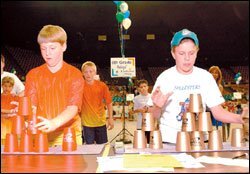Schools Use Cup Stacking to Teach Coordination
Americans will compete at just about anything, including eating hot dogs and rolling logs. Now, cup stacking joins that list.
Robert W. Fox, 46, a former physical education teacher, promotes cup stacking as a sport that can be taught in schools. About 7,000 schools incorporate the activity into their PE classes, he said, and students compete in annual world cup-stacking tournaments.
The challenge involves stacking and unstacking 12 specially designed plastic cups in specific sequences.

“It is pretty easy to catch the pattern of how to do it,” Mr. Fox said. The real challenge is to do it faster and faster each time.
“I first saw cup stacking in 1990 on ‘The Tonight Show with Johnny Carson,’ ” Mr. Fox said. In 1995, when he became a PE teacher at the 650-student Coyote Creek Elementary School in Highlands Ranch, Colo., he decided to teach it to students.
Mr. Fox realized immediately that the youngsters loved the activity. “I offered after-school programs for cup stacking, and hoped for 25 students,” he said, “but ended up with 200.”
Although it doesn’t involve exercise, cup stacking benefits students’ hand-eye coordination, Mr. Fox said. Athletic coaches say it helps players learn to use both hands with equal ease, he noted.
Mr. Fox and his wife, Jill, founded the World Cup Stacking Association to promote the sport.
Rhonda Holt, the National Association for Sport and Physical Education’s teacher of the year for 2000, was skeptical when she heard the cup-stacking “noise” in the halls at the conference where she met Mr. Fox.
Still, the 28-year PE teacher at the 460-pupil Peterson Elementary School in Wichita, Kan., said she tried cup stacking and liked it because it’s not restricted to the gym.
“We’re always looking for new things to add to the curriculum,” she said. “And this activity has a great value, because the students use both hands.”




